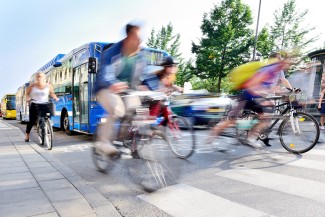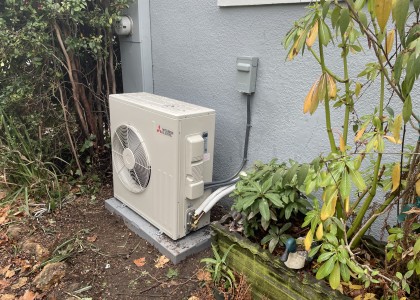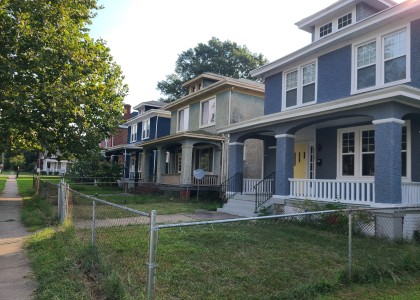This post is the third in a series on transportation system efficiency. The first post focused on policies to support mass transit, walking, and biking, and the second outlined how land use policies can support low-carbon transportation.
Achieving climate goals in an equitable way will require a monumental shift in how cities invest in their transportation systems. Recent federal legislation provides localities with historic funding to redefine their transportation systems to be low-carbon, efficient, and equitable.
Federal funding favors highway and road expansions over other forms of transportation infrastructure, resulting in transportation systems that do not meet the mobility needs of many. For example, only about 20% of funding from the Highway Trust Fund, the largest federal source of funding for public transit, is allocated to transit, while 80% goes to highways. This imbalance in funding disproportionately impacts Black and Hispanic households as they are much more likely not to have a vehicle and depend on modes like transit. Additionally, Black and Hispanic households are often served by lower-quality transportation than white households. In a 2017 Rutgers study, Black, Latino, and mixed-race respondents were more likely to report a lack of bike paths or trails and bike racks in their neighborhoods compared to white respondents, and white respondents were more likely to classify their bike infrastructure as “excellent.” Federal investments should, therefore, take into careful consideration existing gaps in transportation needs and access.
Cities and states can use the 2021 infrastructure law to fund efficient transportation
The Infrastructure Investment and Jobs Act included billions of dollars to help address these problems. Passed in 2021, the law includes an additional $48 billion for public transit and created several new grant programs to fund bike and pedestrian projects. Additionally, the U.S. National Blueprint for Transportation Decarbonization, released in January, outlines mode shift as a critical strategy for meeting nationwide climate goals and will help guide key transportation infrastructure investments.
Infrastructure law funding should be used to prioritize improving access to low-carbon transportation. This includes policies at the intersection of land use and transportation planning, such as "complete streets" projects that convert existing roads designed almost entirely for personal vehicles into roads designed for all modes. Improvements such as creating better bus amenities like shelters or seating, bus-only lanes to improve reliability, frequent pedestrian crossings, and protected bike lanes can reduce reliance on cars and reduce climate pollution. Setting goals for each mode—biking, walking, transit, and driving—can also help inform investment decisions.
Transit funding in the law can be used for more reliable bus and rail service, new light or heavy rail lines, and the creation of affordable and on-demand microtransit systems connecting households with key services and job centers. Transit improvements are especially beneficial to people who may struggle to afford the costs of car ownership, so decisions about which options to pursue should fully incorporate the voices of disadvantaged communities.
To achieve more equitable transportation with less climate pollution, cities can apply for funding through a number of programs created by the infrastructure law and the Inflation Reduction Act. The programs listed below are subject to the Justice40 Initiative, which established a goal of 40% of the benefits of certain federal investments going to disadvantaged communities. Applicants to these programs should consider how their projects will benefit communities harmed by past transportation planning decisions or lack access to affordable transportation.
The Reconnecting Communities Pilot Program provides $1 billion to projects that address barriers to community connectivity created by roads and other transportation facilities. The funding can be used to remove roadways, construct transit facilities, build pedestrian overpasses, carry out complete-street conversions, and implement other projects that help bring communities back together. Tucson, Arizona, received $900,000 to plan and design a new bike and pedestrian bridge over I-19, a highway that has divided several largely Hispanic neighborhoods and isolated them from economic opportunities, medical facilities, and greenways. While the fiscal year 2022 funding has already been awarded, the U.S. Department of Transportation plans to award roughly $200 million each year through 2026.
The Safe Streets and Roads for All Grant Program provides $5 billion for projects to reduce roadway deaths and serious injuries. Cities can receive funding for sidewalk installation, transit stop signage improvements, bike lanes, and other projects to improve safety. More than 500 communities received funding in the first round, including Louisville-Jefferson County, Kentucky, which received $21 million to reconfigure ten high-risk roadways with bike lanes, sidewalks, crosswalk enhancements, and other safety improvements, projects that also have greenhouse gas reduction benefits. The program is currently accepting applications for fiscal year 2023, and the deadline is July 10.
Formula funding from the new Carbon Reduction Program can be allocated to projects that reduce transportation emissions, such as bus rapid transit corridors, on-road and off-road trails, strategies to increase vehicle occupancy, and transportation demand management programs.
The Strengthening Mobility and Revolutionizing Transportation (SMART) Grants program supports projects that advance transportation efficiency through innovative community technologies, including paratransit scheduling system improvements, digital assessment of sidewalk and bus shelter conditions, and enhancement of income-based transit fare programs through database integration. Miami-Dade County received nearly $2 million to implement technologies to scale zero-emission last-mile freight deliveries. The project will feature cargo-bikes and cargo-storing hubs in tandem with digital infrastructure to cut greenhouse gas emissions in the final step in delivering products to customers. The application period for the second round of SMART grants is expected to begin in summer of 2023.
The General Services Administration set up an interactive dashboard to track projects that have been awarded funding from the infrastructure law.
The Inflation Reduction Act can also fund transportation efficiency for disadvantaged communities
Though the Inflation Reduction Act provides expanded subsidies for electric vehicles, it also recognizes that increasing EV access alone will not be enough to meet climate targets for the transportation sector.
The law created the Neighborhood Access and Equity Grant Program, which can also fund projects prioritizing efficient transportation modes. The federal government is developing guidance for states and localities to apply for the funding. The program is expected to launch later this spring. It is designed to support access to transportation for disadvantaged communities and could be used for locating low-income housing near transit or subsidizing transit passes for low-income residents.
Community engagement and leadership are critical to successful transportation efficiency programs
The success of transit, bike, and pedestrian infrastructure investments will depend heavily on whether they respond to the needs of the communities where they are implemented. When designing projects for federal funding, it will be critical for states and cities to reach out to local community-based organizations and advocates to identify community-responsive projects. These organizations can also provide guidance on the best methods for engaging with the community. Effective strategies include building relationships with leaders of communities that don't speak English, reducing barriers to participation (such as by providing meals or childcare), establishing a working group with decision-making power, and hosting trainings on structural racism for municipal staff.
Localities that choose to spend infrastructure law and Inflation Reduction Act money on highway expansion over safer and more sustainable modes of travel risk increasing greenhouse gas emissions and perpetuating historical transportation inequities. By prioritizing modes of transportation other than personal vehicles and bringing disadvantaged communities to the decision-making table, cities can leverage new federal funding programs to achieve their climate and equity goals.



